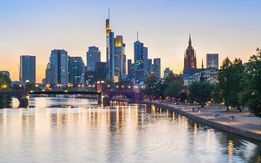Gold – typical colour of the baroque style
News Arnulf Hinkel – 17.04.2020

Since 2008, artists Aleksandra and Alexander Grychtolik have been ambassadors of harpsichord music, and with great success. As soloists and with their “Deutsche Hofmusik” ensemble, they perform at leading classical music festivals worldwide, inspiring audiences and critics alike. In 2017, the major German daily newspaper Süddeutsche Zeitung attested to Alexander Grychtolik’s ability to “speak Bach perfectly”. Because audiences are moved by the baroque improvisations and are often as interested in the Grychtoliks’ musical instruments as in the music itself, the gilding of one of their valuable, beautifully crafted concert harpsichords was an obvious idea.
„We want the baroque era to come alive in our concerts. It was a period characterised by splendour in representation and elaborate celebrations, which were often accompanied by live harpsichord music. And gold, of course, has always and more than anything else been an emblem of luxury. “
Aleksandra and Alexander Grychtolik
Instrument gilding: a rare art form
While searching for a specialist to commission with the gilding of their harpsichord, the Grychtoliks came across Berlin-based Jessica Zappe, who runs one of the few studios for harpsichord decoration in Europe. If there is anything like a typical career path for a harpsichord gilder, then Jessica Zappe has certainly did not followed it. She started out studying physics and maths to become a teacher before turning her hobby into a profession. As a lover of harpsichords and baroque music, she acquired the necessary specialist knowledge on her own. This was not an easy feat: she studied history books to learn about the colouring and ornamentation of harpsichords of the baroque style and experimented with various materials and working methods. Throughout her learning experience, she was supported by her global network of harpsichord players, gilders and lovers of the instrument, style and music. After a number of smaller jobs, she was able to open her studio in 2008. She has since become a sought-after specialist for harpsichord gilding and is commissioned by clients from across the world, private owners of instruments well as universities located as far away as Melbourne and Michigan.
A process based on tradition and experience
As a first step in the gilding of an instrument, Zappe draws the original-scale pattern of the ornaments on parchment paper, thus creating a blueprint for the gold decoration of the harpsichord. The contours of the parchment paper blueprint are then carefully punctured with a needle until the entire drawing is perforated.

In a next step, the gilder places the blueprint on the designated surfaces of the harpsichord and wipes it carefully with a cloth dipped in chalk. The resulting chalk marks on the harpsichord serve as the outline for the application of the so-called micturition. The micturition is a special adhesive which serves as a base for the application of the gold. There are different micturition types that can be used for gilding, based either on oil, alcohol or acrylic. Zappe prefers to work with acrylic: “The acrylic-based micturition dries faster than all the others.”

All gold is not created equal
The micturition is applied successively in small sections on the harpsichord, because the time frame for the optimal degree of drying before the gold leaf application is relatively narrow. “Learning the optimal size of one such section was a process of trial and error, and it took a long time,” Zappe recalls.

The choice of gold is decisive for a successful outcome. In theory, a gilder can use either a high-gloss or silk-matte finish, but for a harpsichord the latter is clearly preferable. Through years of experience, Zappe determined that a particular transfer gold, Ducat Double Gold, is the optimal product for her work. Its wafer-thin sheets can be easily removed from their parchment paper base and flexibly applied to a surface. The gilder prefers the 23-carat gold, as 18-carat gold has proven too thin to survive the stresses and strains of a harpsichord, especially if it is an instrument frequently transported to concerts, as is the case with the Grychtoliks. The individual gold leafs are placed next to each other on the harpsichord surface. The lines along which they meet are carefully flattened with a brush and thus become imperceptible.

Once the gold has been applied, the brush is used to remove any protruding particles, which is quite simple, as the gold leaf is adhesive only where micturition has been applied.
The gilding of a harpsichord: two months’ work
After the application of the gold ornaments, the expert lets her work dry for a few days before polishing the surface with a special cloth. A clear varnish is then applied as a protective layer against abrasion or impact damage. In a next step to create more visual depth, the ornamental pattern is shaded with a brownish colour, before the entire surface is sealed with clear varnish in a final step.

Next project: a golden rococo harpsichord frame
The Grychtoliks are looking forward to presenting their newly gilded harpsichord at a concert. “We like to think that the noble appearance of our instrument will inspire the audience and convey the high standards we have set for ourselves. Through our daily practice together, we are constantly working on upholding them,” says Aleksandra Grychtolik, explaining her enthusiasm for the precious metal. Their next project: the gilding of a harpsichord frame in the rococo style.

Arnulf Hinkel
Financial Journalist
More information is available here:
Interesting articles about gold
Interesting articles about gold
Xetra-Gold Hotline

Do you have questions? We have the answers. Contact us here: 9 a.m.–6 p.m. CET
xetra-gold(at)deutsche-boerse.com
For press inquiries: media-relations(at)deutsche-boerse.com



